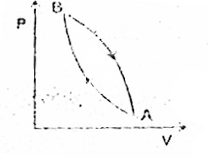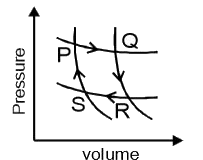In the previous question
(i) work is done by the gas
(ii) work is done on the gas
(iii) heat is absorbed by the gas
(iv) heat is given out by the gas
(i),(iii)
(ii),(iii)
(iii),(iv)
(i),(ii)
The correct Answer is:C
Clockwise cycle on V−P diagram ΔWcyclic=−ve=ΔQcyclic
Work is done on the gas, heat is given out by the gas
Topper's Solved these Questions
Similar Questions
no work is done against gas.
View SolutionIn a cyclic process shown in the figure an ideal gas is adiabatically taken from A to B the work done on the gas during the process A→B is 80 J, when the gas is taken from B to a the heat absorbed by the gas is 40 J. What will be work done by the gas in process B→A?

View Solution
Knowledge Check
A gas expands in vacuum, the work done by the gas is
AzeroBminimumCmaximumDequal to the work done on the gasA fixed mass of gas undergoes the cycle of changes represented by PQRSP as shown in figure. In some of the changes, work is done on the gas and in others, work is done by the gas. In which pair of the changes work is done on the gas ?
 APQ and RSBPQ and QRCOR and RSDRS and SP
APQ and RSBPQ and QRCOR and RSDRS and SPStatement 1: Heat supplied to a gas is process is 100 J and work done by the gas in the same process is 120 J, then pressure of he gas in the process should increase.
because
Statement2: Work done by the gas is greater than the heat supplied to the gas. Hence, internal energy of the gas should decrease.AStatement -1 is true, Statement -2, is true, Statement-2 is a correct explanation for statement-1.BStatement -1 is true, Statement -2 is true, Statement -2 isnot a correct explanation for statement -1CStatement -1 is true, Statement -2 is false.DStatement -1 is false, Statement -2 is true.
Work Done By A Gas
View SolutionStatement 1: Heat supplied to a gas is process is 100 J and work done by the gas in the same process is 120 J, then pressure of he gas in the process should increase.
because
Statement2: Work done by the gas is greater than the heat supplied to the gas. Hence, internal energy of the gas should decrease.
View SolutionTwo moles of an ideal gas was heated isobarically so that its temperature was raised by 100 K. The heat absorbed during the process was 4000 J. Calculate (i) the work done by the gas, (ii) the increase in internal energy and (ii) the value of y for the gas [R=8.31Jmol−1K−1].
View SolutionWork done by a gas in a given process is −20J. Heat given to the gas is 60J. Find change in internal energy of the gas.
View SolutionThe ratio of work done by an ideal diatomic gas to the heat supplied by the gas in an isobatic process is
View Solution
